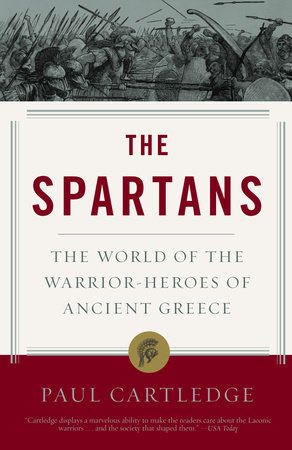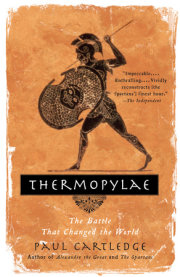Chapter 1
UNDER THE SIGN OF LYCURGUSThe image of Sparta as a dour, barracks-like camp hardly prepares the first-time visitor for the glorious spectacle that unfolds as one emerges from the uplands abutting Arcadia to the north and enters down the Eurotas valley into the Spartan plain. Stretching before one are two parallel mountain chains, that of Taygetus on the west reaching to 2,404 metres at the peak, and that of Parnon on the east (1,935 metres at its peak). The alluvial plain itself, and its continuation south in the Eurotas valley that runs out into the sea in the Laconian Gulf, constitute one of the most fertile and desirable pieces of land in all southern Greece. Soil, climate and man conspire to yield and garner sometimes two harvests of grain in a single year. Olives and grapevines, the other two staples of the so-called Mediterranean diet, flourish here too - as of course does the forest of citrus trees, but they are a post-Classical import, reminding us that the terrain and vegetation we see today are not necessarily those enjoyed by the inhabitants of two and a half millennia ago.
Hardly surprisingly, this region, known in historical times as Lacedaemon, was believed also to have been the seat of a great king in the ancient Greeks' heroic age - what we scholars more prosaically call the Mycenaean or Late Bronze Age (
c. 1500-1100 BC). An attempt has been made very recently (see biography of Helen p. 48) to relocate the palace of Homer's Menelaus from Sparta to Pellana further north in Laconia, but that flies in the face not only of ancient legend and religious worship but also of topographical geopolitics. Any real Late Bronze Age Menelaus must have had his palace in or near the site of historical Sparta - perhaps actually where a large settlement, including a building qualifying as a 'mansion', has been scrupulously excavated by the British School at Athens. However, no contemporary palace on the scale of those excavated at Mycenae (seat of Homer's Agamemnon, brother of Menelaus) and Pylos (capital of garrulous old Nestor) has yet come to light in Laconia - and perhaps never will. It is important not to read Homer as a straight history textbook, however archaeologically productive that mistake has undoubtedly been.
HELEN
Helen of Troy - or Helen of Sparta? She was, of course, both. A local girl, daughter of Tyndareus, according to one version of her myth, but yet, according to another version, daughter of great father Zeus and born miraculously from an egg because her mother Leda had been visited by Zeus in the disguise of a swan. Her unsurpassed beauty made her a natural prize for the ambitious Menelaus, son of Atreus of Mycenae, whose older son Agamemnon took Helen's sister Clytemnestra for his bride. However, that beauty also captivated an unwelcome visitor to Sparta: Paris, prince of Troy in Asia, overlooking the straits of the Dardanelles, who - aided crucially by the Cyprus-born love goddess Aphrodite - violated the sacred obligations of guest-friendship and robbed Menelaus of his lawfully wedded wife.
Recently, a Greek archaeologist caused a little stir by claiming that he had located Helen's (and Menelaus') palace, not at Sparta but at Pellana some fifteen kilometres farther north. That claim would have astonished the ancient Spartans, who built a new shrine for Helen in Sparta, or more precisely at Therapne to the south-east of the ancient town, where she received worship along with her husband Menelaus and her divine brothers the Dioscuri, Castor and Polydeuces (Pollux in Latin). This was in the later eighth century, a time when the Spartans were, so to speak, rediscovering their roots, seeking to legitimize their recently won domain in south-east Peloponnese by presenting it as the legitimate successor of the kingdom of Menelaus as set out in Homer's
Iliad. In actual fact, the cult of Helen at Therapne probably reflects a conflation of two Helens: one a goddess of vegetation and fertility associated with trees (also worshipped as such on Rhodes), the other the heroic Helen of Homeric legend. We shall stick with the latter.
More specifically, since Helen served later as an icon of Spartan womanhood and beauty, we must ask, was Helen raped (according to our usage of that term) by Paris or did she go with him consensually, of her own accord? Herodotus, father of history (in the phrase of Cicero), has three very interesting passages regarding Helen. The first comes in his opening aetiology of the Graeco-Persian Wars of the early fifth century, where he traces the history or mythography of Greek-Oriental enmity back through the mists of time and legend. A series of claims and counter-claims is wittily rehearsed, with Herodotus purporting merely to relate the stories he has been told by learned Phoenicians and Persians. Among them features, inevitably, the theft, if that is what it was, by Paris of Helen. Herodotus himself adopts a robust, not to say male chauvinist, view of the matter:
it is obvious that no young woman allows
herself to be abducted if she does not wish to be.However, an unambiguous tale, not related by Herodotus, of an earlier rape of Helen, effected by Theseus of Athens when she was but a girl rather than an adult wife, tells a different story. Lately, both Elizabeth Cook in her imaginative retelling of Achilles' story and John Barton in his no less powerful
Tantalus play-cycle have reminded us opportunely of this earlier, darker chapter in Helen's eventful life.
The next reference to Helen in Herodotus is, if anything, even more disturbing, from the historical point of view. For according to him, as he relates it in his account of matters Egyptian in the second book of his Histories, she never went to Troy at all, but sat out the ten years of the Trojan War in Egypt:
This is the account the Egyptian priests told me
of Helen's story, and I am inclined to accept it, on
the following ground: had Helen really been in
Troy, she would have been handed back to the
Greeks whether Paris consented or not... This, then,
is my own interpretation.It was thus, for Herodotus, merely to recover a simulacrum, a phantom double, of Helen's face that Menelaus and Agamemnon and all the other Greeks had launched their thousand ships!
This heterodox version, for obvious reasons unused by Homer, was not original to Herodotus, since we know that it was being peddled as early as the mid-sixth century by the Greek lyric poet Stesichorus, from Himera in western Sicily. And after Herodotus it was again found congenial by the great Athenian dramatist Euripides, who based his surving melodrama
Helen upon it; but for most ancients, as for most of us, Helen can safely remain Helen of Troy.
The third mention in Herodotus brings us back from Egypt to Sparta and more precisely to Helen's shrine at Therapne, which was the setting of a classic folktale, beautifully retold by Herodotus for his fifth-century audience. Once upon a time, somewhere in the second half of the sixth century in our terms, a wealthy Spartan couple had a daughter, but, alas, their beloved infant was distressingly plain. So plain that the family's nurse - perhaps a Helot woman - had the following bright idea:
Since she was plain to look at, and her parents,
who were well off, were distressed at her
unsightliness, her nurse had the idea of carrying
her every day to the shrine of Helen at what is
called Therapne, above the shrine of Apollo. She
would take the baby in, lay her in front of Helen's
cult-statue, and pray to the goddess to rid her of
her ugliness.One day, an apparition - clearly meant to be Helen herself - addressed the nurse and stroked the child's head, whereafter she grew up to be the most beautiful of all the nubile Spartan girls, a suitable match and catch for a leading Spartan. Unfortunately for that Spartan, however, he had a best friend who was childless and who passionately fancied the friend's wife as the bearer of his own future, ideally male, offspring. Even more unfortunately, the best friend just happened to be a king of Sparta, for whom the production of legitimate male offspring was an affair of state and not just of the heart. In his intense desire to procreate this king had already married not just once but twice; now, besotted with his friend's wife, he added insult to injury, obtaining her from him by a low trick.
The product of the union of Ariston - for that was the king's name - with the unnamed female beauty was King Demaratus, whom we shall meet again later in circumstances of alleged illegitimacy and treachery - everyday charges in the fraught world of Spartan royalty. (See further his biography, in Chapter 2.) However, before we leave Helen, it is worth mentioning three very different expressions and consequences of her legend. First, as early as the seventh century, the priestess of Apollo at Delphi, the navel of the earth, issued a prophetic utterance on behalf of her lord and master Apollo that was translated by the male priests to include a reference to the women of Sparta, hailing them as the most beautiful in all Greece. That can only have been a bow to Helen of Sparta, whose fame, thanks to Homer, was spreading throughout the expanding Greek world, though it will have surely also put undue pressure, as we have seen, on Spartan girls and their parents to try to live up to Helen's awesome reputation.
Later, in the seventh century, the greatest of the ancient Greek women poets, Sappho from the island of Lesbos, engaged with Helen's reputation more than once. Sappho's verses can be quite conventional, as for example in the small fragment addressed to some beautiful and desired adolescent girl or young woman:
whenever I look at you
it seems to me that not even Hermione
[daughter of Helen]
is your equal
no, far better to compare you
to Helen, whose hair was golden.On the other hand, Sappho could also be deeply and disturbingly unconventional. Flying in the face of normative, male value judgments, she writes, in a poem that happily survived on papyrus for centuries in the dry sands of Oxyrhynchus in Egypt, and was excavated only a century or so ago:
Some say a troop of horsemen, some an army on foot
and some a fleet of ships is the most lovely sight
on this dark earth; but I say it is that which
you desire:
... for the woman who far excelled all others
in her beauty, Helen, left her husband -
the best of all men -
behind and sailed far away to Troy; she did not spare
a single thought for her child [Hermione]
nor for
her dear parents
but [Aphrodite]
led her astray...So Sappho both rejects masculine military values and at the same time excuses Helen's pursuit of the path of Love and Desire as being due to divine force majeure. That is not a message that the average Greek husband would have been delighted to hear.
The final expression and consequence I want to mention here is altogether more lighthearted, indeed literally comic. In 411 Aristophanes staged two comedies at the two major annual Athenian play-festivals in honour of Dionysus. One of these was the Lysistrata, the first known comedy to have been named after its heroine. Lysistrata, a respectable Athenian married woman, is portrayed respectfully. Seeking to put an end to the war between Athens and Sparta and their allies, which had been raging on and off for some twenty years (twice as long as the Trojan War), she organizes an international conspiracy of Greek women - or rather wives: the big idea is that their withdrawal of conjugal rights, a sex-strike, will force their bellicose but sex-starved husbands to the negotiating table and compel them to make peace (and so be able to make love once again) at last. The Spartan sororal delegate to the convention is one Lampito - she bears a good Spartan name, in fact the real name of the wife of a very recent Spartan king.
Here is how Aristophanes introduces Lampito (played of course by a male actor, in drag):
Welcome, Lampito, my very dear Spartan friend!
[says Lysistrata]
Sweetest, what beauty you display! What a fine colour of skin,
and what a robust frame you've got! You could throttle a bull!To which Lampito replies, in broad local Spartan dialect:
Yes, indeed, I reckon I could, by the Two Gods [Castor and Pollux];
at any rate, I do gymnastics and heel-to-buttock jumps.Another Athenian co-conspiratrix joins in the fun:
What a splendid pair of tits you've got!
Lampito affects to be offended by this:
Really, you're feeling me over like a sacrificial victim.The mainly Athenian audience, in between its guffaws, could hardly miss the allusion to the fact that Spartan women, unlike their own wives and sisters, were given a formal public training in gymnastics and athletics, performed either completely naked or at least partially nude. Perhaps too through these exercises Spartan women, unlike Athenian women, managed to keep their breasts in shape even after suckling babies - unless, of course they regularly resorted to Helot wet-nurses.
The
Lysistrata ends also on a completely Spartan note, with first a Spartan man individually, and then Spartan couples jointly singing and dancing specifically Spartan songs and figures (the Greek word 'chorus' meant originally dance, before it came to mean collective singing). Notice particularly the final invocation of Helen, 'Leda's daughter':
Leave lovely Taygetus again
and come, Laconian Muse, and fittingly
praise the god of Amyclae [Apollo]
and Athena of the Brazen House
and the noble sons of Tyndareus
[Castor and Pollux]
who play beside the Eurotas.
Ola! Opa!
Prance lightly, that
we may hymn Sparta,
which delights in god-honouring dances
and in the beat of feet,
and where, like fillies, the maidens
prance beside the Eurotas,
raising dustclouds with their feet,
shaking their hair
like the hair of bacchantes who wield the thyrsus and dance.
And they are led by Leda's daughter,
their pure and beautiful chorus-leader.In or around 1200 bc, the Mycenaean mansion at Therapne was burnt and destroyed, and the number and quality of the settlements in the region as a whole fell away drastically, so that by 1000 it is possible to speak of Laconia as undergoing a Dark Age. Some shafts of light are dimly visible in Sparta of the tenth and ninth centuries, for example at the shrine of Orthia by the Eurotas that would grow to play a key role in the later Spartan Agoge or Upbringing. However, it is not until the late eighth century, archaeologically, that the light becomes brighter and more evenly diffused. By then, there had been constructed a sanctuary to the city's patron goddess Athena, on what passed for an acropolis in Sparta; this is the Athena who later, in the sixth century, acquires the tag 'of the Brazen House' used by Aristophanes at the end of his
Lysistrata (above). There was also an important sanctuary of Apollo in Amyclae just a few kilometres to the south of Sparta, also noted in the
Lysistrata, and it is here rather than in Sparta proper that myth, religion and politics coalesced to produce the first glimmerings of a political history of the origins of the Spartan polis or state.
Copyright © 2004 by Paul Cartledge. All rights reserved. No part of this excerpt may be reproduced or reprinted without permission in writing from the publisher.









